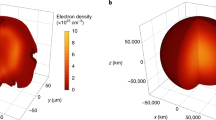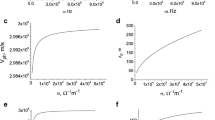Abstract
THE great number of unsuccessful attempts to observe a spark spectrum of lithium have proved the difficulty of exciting, by means of the ordinary methods, the spark spectrum of an element when the excitation potential is high compared with that of the arc spectrum of the same element. Owing to the great interest which is attached not only to the lithium spark spectrum, but also to many other spark spectra which have hitherto not been observed, experiments have been carried on at this Institute during the last two years with the purpose of developing a method which should make it possible to produce spark spectra having a high value of the excitation potential. An apparatus was designed, in which the vapour of the element under investigation was allowed to escape into a high vacuum from a little hole in a crucible, heated by an electric furnace, and where this vapour could be exposed to a bombardment by a strong current of electrons. By evacuating the apparatus to a pressure below 0·001 mm., and by means of a special design of the orifice of the crucible, it was possible to produce and accelerate these electrons, before they could collide with the atoms of the escaping vapour. In the latest construction of the apparatus, the distance from the tungsten filament to the grid was 1-2 mm., the distance from grid to the crucible 10-15 mm., and the electron current was, by means of an anode behind the crucible and a ring near the grid, concentrated on the hole of the crucible where the concentration of vapour was a maximum. The electron current was usually of the order of 200-300 ma, but could without difficulty reach more than 500 ma. Accelerating voltages up to 1400 volts have been applied.
This is a preview of subscription content, access via your institution
Access options
Subscribe to this journal
Receive 51 print issues and online access
$199.00 per year
only $3.90 per issue
Buy this article
- Purchase on Springer Link
- Instant access to full article PDF
Prices may be subject to local taxes which are calculated during checkout
Similar content being viewed by others
Author information
Authors and Affiliations
Rights and permissions
About this article
Cite this article
WERNER, S. On the Excitation of Spark Spectra. Nature 115, 191–192 (1925). https://doi.org/10.1038/115191a0
Issue Date:
DOI: https://doi.org/10.1038/115191a0
Comments
By submitting a comment you agree to abide by our Terms and Community Guidelines. If you find something abusive or that does not comply with our terms or guidelines please flag it as inappropriate.



